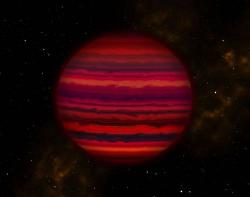
The clouds were seen on a brown dwarf star 7.2 light years away from Earth
Astronomers could barely see it. The brown dwarf known as WISE 0855 is 7.2 light years away from Earth, and the largest telescopes that are ground-based can barely make out the failed star. Last week, using the Gemini North telescope on top Mauna Kea, a team of astronomers from UC Santa Cruz were able to gather an infrared spectrum of WISE 0855, which showed strong evidence of water clouds. It is the first instance of water clouds found outside the solar system, and it pushed the boundaries of what can be done with a telescope on earth.
Andrew Skemer, lead author of the paper detailing the findings, says that the discovery is not totally unexpected. WISE 0855 is the coldest known object outside our solar system, with a temperature of about minus 10 degrees Fahrenheit. “We would expect an object that cold to have water clouds, and this is the best evidence that it does,” said Skemer.
WISE 0855 is five times fainter than any other objected detected from Earth, according to Skemer. It is too dim for typical spectroscopy at near-infrared or optical wavelengths. The team had to rely on thermal emission in an extremely narrow range from the deep atmosphere. They observed WISE 0855 for about an hour per night for 13 nights.
The result was that the spectrum showed the failed star dominated by clouds and water vapor, with an overall appearance “that is strikingly similar to Jupiter.” Skemer said that if it was possible to see infrared light with the naked eye, the data would appear as a “rainbow of colors.” He said, “The relative brightness of each color gives us a glimpse into the environment of the object’s atmosphere.”
The team developed atmospheric models to help them understand what WISE 0855 might look like. The spectrum seemed to most closely approximate a cloudy model. They also noted water absorption features that were very similar to Jupiter. However, WISE 0855 does not show the abundant phosphine found in Jupiter’s atmosphere, which means that WISE 0855’s atmosphere is likely calmer.
WISE 0855 is too small to be considered a star and too large to be a planet. It is about five times the mass of Jupiter. During the process of forming it was unable to gain enough mass to start the process of nuclear fusions that make a star.

Leave a Reply